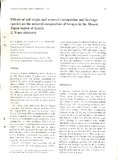| dc.description.abstract | Samples of topsoil and herbage from 135 sites in the Mt Elgon region of Kenya were classified according to farm, site altitude, underlying soil bedrock (6 types) and botanical composition (6 classes). Effects of altitude, bedrock and species on pasture concentrations of Co, Cu, Fe, Mn, Mo, Se and Zn were determined using a mixed model for unbalanced data sets and the Wald statistic (W) to assess statistical significance. Extractable concentrations of each element in the soil were measured at each site except for Se where total Se was used.
Cu values were particularly low in forages associated with tertiary volcanic bedrock (3.8 ± 0.34 mg/kg DM), but even the maximal values (5.4 ± 0.34 mg/kgDM on metamorphosed sediImentary material) were marginal for ruminants. Se and Cu concentrations were usually low at low altitudes but no other significant effects of altittude or geology on herbage trace element concentrations were found. For Cu and Se alone, geological and topographical maps may help to delineate areas where risks of deficiency are high or low. Herbage composition was poorly correllated with total (Se) or extractable (other trace elements) concentrations in the soil.
Species differences were important for all elements except Se, with kikuyu grass (Pennis- etum clandestinum) the richest in all but Mn. For Cu and Zn, deficiencies were most likely to occur with rhodes grass (Chloris gayana) with 3.5 mg Cu and 19.5 mgZn/kg DM and setaria (Setaria sphacelatai with 3.9 mg Cu and 17.7 mg Zn/kg DM. Species differences in Mo were within a low range of values (derived means < 1.6 mg/kgDM) but may, in combination with S, influence Cu availability. The lowest mean Se value (0.047 mg/ kgDM in setaria) was inadequate for ruminants. Species variation in Co, Fe and Mn was significant but values were consistently above animal requirements and for Co and Fe were probably influenced by soil contamination. | en |

